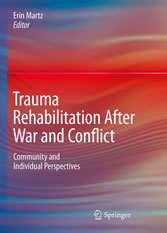Search and Find
Service
More of the content

Trauma Rehabilitation After War and Conflict - Community and Individual Perspectives
"Chapter 9 Psychological Rehabilitation of Ex-combatants in Non-Western, Post-conflict Settings (p. 177-178)
Anna Maedl, Elisabeth Schauer, Michael Odenwald, and Thomas Elbert
Abstract Disarmament, demobilization, and reintegration (DDR) programs are part of most international peace-building efforts and post-conflict interventions in developing countries. Well over a million former combatants have participated in DDR programs in more than 20 countries, the vast majority of them in sub-Saharan Africa. The impact, however, has remained disappointing.
A significant portion of ex-combatants suffer from mental-health issues, caused by repeated exposure to severe psychological distress. Individuals with PTSD, depression, substance dependence, or psychotic conditions are heavily impaired in their daily functioning. It is often difficult for them to reintegrate into civilian society, and they are less able to support the process of reconciliation and peace-building within their communities and postwar areas at large. Others, who as child combatants adapted to a culture of violence and aggression, have never been taught the moral attitudes and the behavioral repertoire that are required in peaceful settings.
These failures to adjust fuel cycles of violence that might reach across generations. Psychological components of DDR programs are frequently neither suffi- ciently specific nor professional enough to address reintegration failure and the threat of continuing domestic or armed violence. This chapter presents examples from post-conflict settings, in which specific and targeted mental-health interventions and dissemination methods have been successfully evaluated, including Narrative Exposure Therapy and Interpersonal Therapy.
It suggests a comprehensive, community-based, DDR program, which offers mental-health treatment for affected individuals, as well as community interventions to facilitate reintegration and lasting peace. Introduction: Violent Conflicts on aWorldwide Scale Currently 34 large-scale armed conflicts and 3 wars are being fought worldwide (Harbom, Melander, & Wallensteen, 2008). Most of them can be found in non-Western countries, and 13 major wars were recorded in the last decade in Africa alone (Harbom & Wallensteen, 2008).
The type of warfare has profoundly changed since World War II. The so-called new wars (Kaldor, 2004) or ‘complex political emergencies’ (Ramsbotham &Woodhouse, 1999) mainly take place as internal con- flicts in non-developed countries. Warring factions largely rely on irregular forces, forced recruitments, and the use of fear and violence to gain control over the population and to maintain their power within their own fighting forces. Crimes against humanity, like mass rape, mutilations, and torture, are not an exception, but a deliberate strategy in this context. As a result, the social and economic bases of whole regions are completely destroyed and millions of people are displaced. The UNHCR (2008) estimates that by the end of 2007, about 42 million people had fled their homes from violent conflict."
All prices incl. VAT












